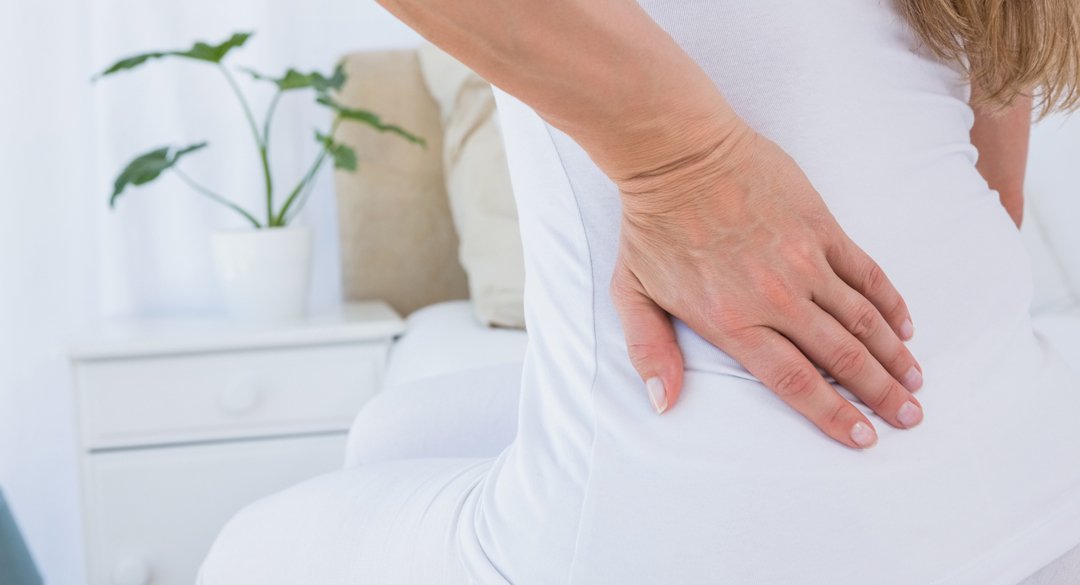
Low back pain can happen to anyone, and it’s actually quite common. About 70 percent of people in the U.S. will experience some form of low back pain in their lifetime. Fortunately, back pain usually heals on its own, and it also responds well to treatment.
There are many causes of low back pain, from sitting too long, being in a car accident or even sleeping the wrong way. Medication might be used for a short time to calm back pain and spasms, but usually low back pain can be treated successfully with therapies such as physical therapy, chiropractic care, osteopathic manipulation and simple home exercises.
What is low back pain?
Most people typically think of joints as knees and shoulders. But the back is made up of many small joints, too. These small back joints don’t have the same range of motion as your knee, but they can still get injured or inflamed.
Mechanical low back pain is a commonly used term that refers to back pain coming from the muscles and joints. It encompasses pain that you feel along the spine below the ribs down to your tailbone. Sometimes the pain can even extend from the back into one or both legs.

If the pain occurs very suddenly and intensely, we call it acute low back pain. If it flares up on and off over time with varying levels of pain intensity, this is what we call chronic low back pain. It’s rare, but some types of back pain can be signs of more serious medical issue such as cancer or internal organ disease, so it’s important to see your health care provider if your symptoms aren’t improving after a few weeks.
What causes low back pain?
Everyone has a different story about what aggravates their back, but bending and lifting with poor posture or trying to pick up something that’s too heavy are very common causes of low back pain. When we overload our back muscles, it can cause a strain of the muscles and sometimes a sprain of the joints.
Over time, repetitive bending and prolonged sitting with a less-than-ideal posture also can lead to low back pain. In this case, the source of the pain is often an injured intervertebral disc, which can also cause back spasms and leg symptoms, like numbness or tingling sensations down the legs.
Playing some sports involves quick twisting movements that can “tweak” the back, and so can sleeping in an awkward position. Both of these can irritate or inflame a facet joint — one of the joints along the spine that make it possible to bend and twist. Nerves from the spinal cord run through the facet joints and connect with other parts of the body, so when these joints get stiff or spasm, it makes body movements difficult.
Back pain can also be caused by other health conditions. If back pain wakes you up at night, gets progressively worse and worse, makes your feet or hands numb or your muscles weak, or if your back hurts all the time, see your health care provider for help. They can help you figure out the source of your back pain and determine whether you’re dealing with a more serious condition.
What are common back pain symptoms?
Everyone experiences pain a little differently, but here are some common sensations people feel:
- Stiffness, tightness, pulling sensation in the lower back
- Sharp, stabbing, pain when you twist and bend
- Low back pain / discomfort with moving from sitting to standing
- Pain and stiffness when waking up in the morning
- Pain in the buttock muscles or pelvis
- Pain traveling from the low back/buttocks into the leg
How is back pain diagnosed?
Chronic back pain is diagnosed based on how often your back hurts, how long it lasts and if you repeatedly have the same type of pain. Most back injuries don’t require tests; your health care provider can often make a diagnosis by talking to you about your medical history and performing an exam.
Usually, the source of back pain can be traced back to a particular injury. Typically it’s not necessary to do diagnostic testing such as x-rays, magnetic resonance imaging (MRI) or CT scan (a type of 2-D x-ray) in back pain cases. But if your back pain isn’t responding to treatment, your provider may order tests to determine whether there’s an underlying non-mechanical issues condition that’s causing your back pain.
What is the treatment for low back pain?
Most times, back pain that has a simple cause will go away on its own with rest and time. But there are many treatments available for back pain, and most are non-invasive.
Your health care provider’s first choice for treatment is most often a combination of exercise combined by with hands-on therapy by a trained professional. Commonly physical therapy, chiropractic care, and acupuncture are very effective for decreasing pain, increasing your range of motion and shortening the duration of your discomfort.
Some common ways to relieve low back pain include:
- Exercises to strengthen your back
- Coaching on posture and proper movement
- Spinal manipulation and/or mobilization
- Acupuncture or dry needling
- Trigger-point therapy
If pain is preventing you from completing your normal daily activities, medications can be helpful in the short term to lessen your pain.
For short-term pain relief, we recommend using over-the-counter medications, such as acetaminophen or NSAIDs, including ibuprofen. If you’re still experiencing worsening pain after a week, your provider may consider a short course of a pain killer such as prescription-strength NSAIDS, acetaminophen or muscle relaxers to stop muscle spasms.
In some cases, if your back pain continues to worsen, your provider will have to explore more aggressive medical treatment. Let them know if you’re having progressively worse symptoms, such as leg muscle weakness, numbness and pain and tingling that goes all the way to your feet. Get in touch with your provider if you have trouble urinating, or if your back spasms and pain are constant without relief.
Surgery usually isn’t needed to resolve back pain, but it may be an option to consider when conservative, non-invasive therapies such as stretching, manipulation and acupuncture haven’t helped.
In Your Guide to Managing Low Back Pain, learn more about the healthy habits you can use to keep your back feeling good and to help back pain go away more quickly if it does flare up.
The One Medical blog is published by One Medical, a national, modern primary care practice pairing 24/7 virtual care services with inviting and convenient in-person care at over 100 locations across the U.S. One Medical is on a mission to transform health care for all through a human-centered, technology-powered approach to caring for people at every stage of life.
Any general advice posted on our blog, website, or app is for informational purposes only and is not intended to replace or substitute for any medical or other advice. 1Life Healthcare, Inc. and the One Medical entities make no representations or warranties and expressly disclaim any and all liability concerning any treatment, action by, or effect on any person following the general information offered or provided within or through the blog, website, or app. If you have specific concerns or a situation arises in which you require medical advice, you should consult with an appropriately trained and qualified medical services provider.
